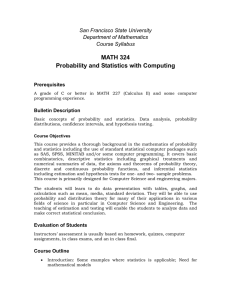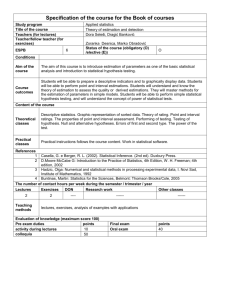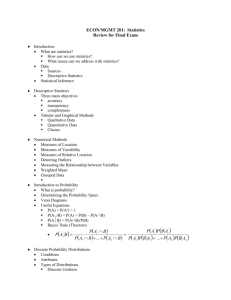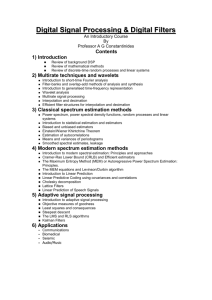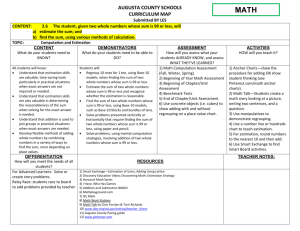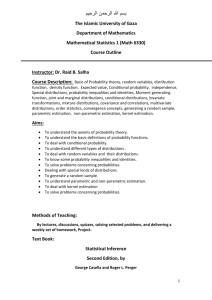Mathematical Statistics – Math 421
advertisement
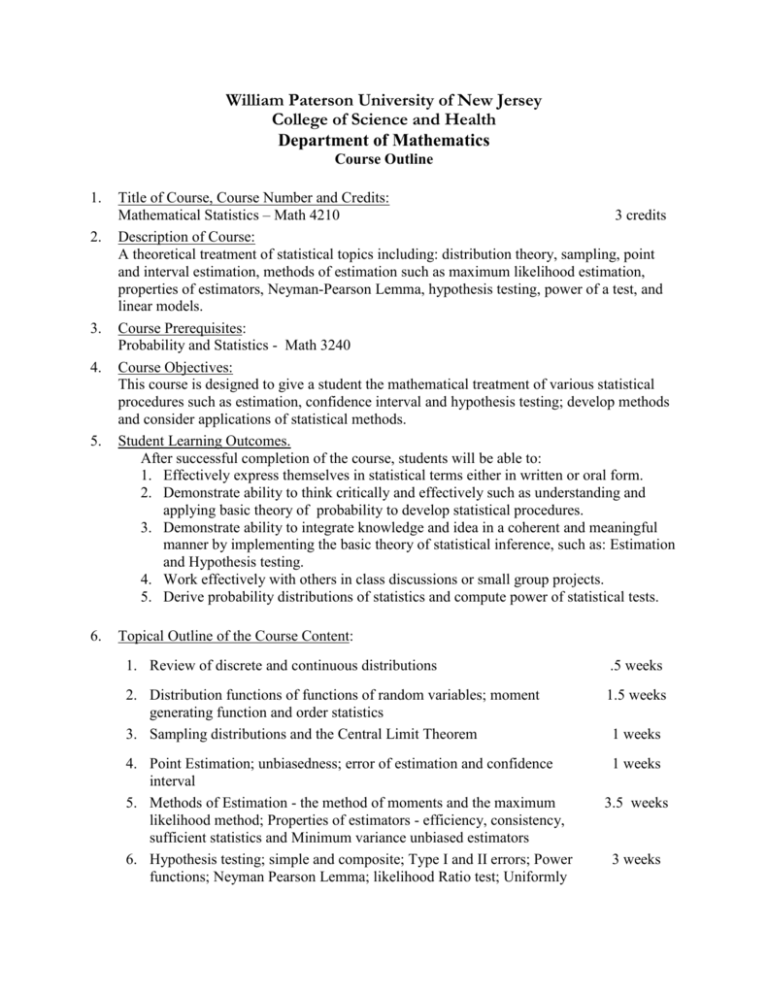
William Paterson University of New Jersey College of Science and Health Department of Mathematics Course Outline 1. 2. 3. 4. 5. 6. Title of Course, Course Number and Credits: Mathematical Statistics – Math 4210 3 credits Description of Course: A theoretical treatment of statistical topics including: distribution theory, sampling, point and interval estimation, methods of estimation such as maximum likelihood estimation, properties of estimators, Neyman-Pearson Lemma, hypothesis testing, power of a test, and linear models. Course Prerequisites: Probability and Statistics - Math 3240 Course Objectives: This course is designed to give a student the mathematical treatment of various statistical procedures such as estimation, confidence interval and hypothesis testing; develop methods and consider applications of statistical methods. Student Learning Outcomes. After successful completion of the course, students will be able to: 1. Effectively express themselves in statistical terms either in written or oral form. 2. Demonstrate ability to think critically and effectively such as understanding and applying basic theory of probability to develop statistical procedures. 3. Demonstrate ability to integrate knowledge and idea in a coherent and meaningful manner by implementing the basic theory of statistical inference, such as: Estimation and Hypothesis testing. 4. Work effectively with others in class discussions or small group projects. 5. Derive probability distributions of statistics and compute power of statistical tests. Topical Outline of the Course Content: 1. Review of discrete and continuous distributions .5 weeks 2. Distribution functions of functions of random variables; moment generating function and order statistics 3. Sampling distributions and the Central Limit Theorem 1.5 weeks 4. Point Estimation; unbiasedness; error of estimation and confidence interval 5. Methods of Estimation - the method of moments and the maximum likelihood method; Properties of estimators - efficiency, consistency, sufficient statistics and Minimum variance unbiased estimators 6. Hypothesis testing; simple and composite; Type I and II errors; Power functions; Neyman Pearson Lemma; likelihood Ratio test; Uniformly 1 weeks 1 weeks 3.5 weeks 3 weeks Mathematical Statistics – Math 4210 most powerful tests; tests based on t-statistics 7. 8. 9. 10. 11. 12. 13. 7. Simple linear models; estimation by least squares method; confidence 2.5 weeks interval and hypothesis testing of regression coefficients. Guidelines/Suggestions for Teaching Methods and Student Learning Activities: Lectures and classroom discussions and problem sessions. Guidelines/Suggestions for Methods of Student Assessment (Student Learning Outcomes) Through quizzes, tests, and final examination Suggested Reading, Texts and Objects of Study: Mathematical Statistics with Applications by Mendenhall and Scheaffer, Duxbury Press. Bibliography of Supportive Texts and Other Materials: 1. Probability and Statistics by M. De Groot, Addison Wesley. 2. Probability and Statistics by H. Larson, John Wiley and Sons. Preparer’s Name and Date: Fall 1979 Original Department Approval Date: Fall 1979 Reviser’s Name and Date: Prof. Z. Chen, Spring 1997 Prof. E. Phadia, Spring 1988 Profs. W. Lim, M. Rosar, D. Cedio-Fengya, Spring 2005 14. Departmental Revision Approval Date: Spring 2005 Page 2 of 2

